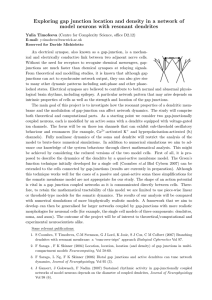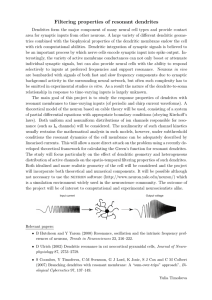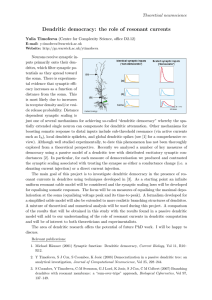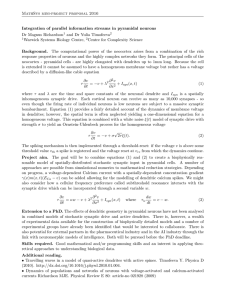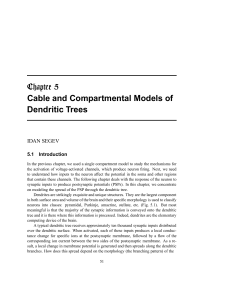Dendritic Democracy
advertisement
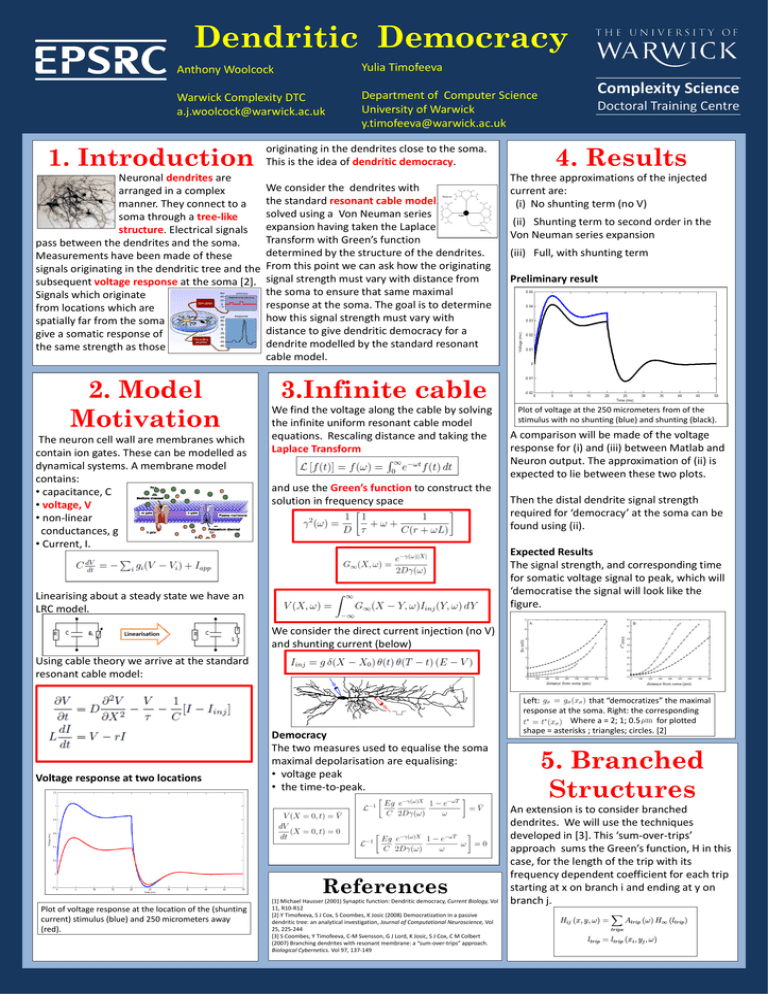
Dendritic Democracy Anthony Woolcock Yulia Timofeeva Warwick Complexity DTC a.j.woolcock@warwick.ac.uk Department of Computer Science University of Warwick y.timofeeva@warwick.ac.uk 1. Introduction Neuronal dendrites are arranged in a complex manner. They connect to a soma through a tree-like structure. Electrical signals pass between the dendrites and the soma. Measurements have been made of these signals originating in the dendritic tree and the subsequent voltage response at the soma [2]. Signals which originate from locations which are spatially far from the soma give a somatic response of the same strength as those 2. Model Motivation The neuron cell wall are membranes which contain ion gates. These can be modelled as dynamical systems. A membrane model contains: • capacitance, C • voltage, V • non-linear conductances, g • Current, I. originating in the dendrites close to the soma. This is the idea of dendritic democracy. We consider the dendrites with the standard resonant cable model. These are solved using a Von Neuman series expansion having taken the Laplace Transform with Green’s function determined by the structure of the dendrites. From this point we can ask how the originating signal strength must vary with distance from the soma to ensure that same maximal response at the soma. The goal is to determine how this signal strength must vary with distance to give dendritic democracy for a dendrite modelled by the standard resonant cable model. 4. Results The three approximations of the injected current are: (i) No shunting term (no V) (ii) Shunting term to second order in the Von Neuman series expansion (iii) Full, with shunting term Preliminary result 3.Infinite cable We find the voltage along the cable by solving the infinite uniform resonant cable model equations. Rescaling distance and taking the Laplace Transform and use the Green’s function to construct the solution in frequency space Plot of voltage at the 250 micrometers from of the stimulus with no shunting (blue) and shunting (black). A comparison will be made of the voltage response for (i) and (iii) between Matlab and Neuron output. The approximation of (ii) is expected to lie between these two plots. Then the distal dendrite signal strength required for ‘democracy’ at the soma can be found using (ii). Expected Results The signal strength, and corresponding time for somatic voltage signal to peak, which will ‘democratise the signal will look like the figure. Linearising about a steady state we have an LRC model. We consider the direct current injection (no V) and shunting current (below) Using cable theory we arrive at the standard resonant cable model: Voltage response at two locations Democracy The two measures used to equalise the soma maximal depolarisation are equalising: • voltage peak • the time-to-peak. References Plot of voltage response at the location of the (shunting current) stimulus (blue) and 250 micrometers away (red). [1] Michael Hausser (2001) Synaptic function: Dendritic democracy, Current Biology, Vol 11, R10-R12 [2] Y Timofeeva, S J Cox, S Coombes, K Josic (2008) Democratization in a passive dendritic tree: an analytical investigation, Journal of Computational Neuroscience, Vol 25, 225-244 [3] S Coombes, Y Timofeeva, C-M Svensson, G J Lord, K Josic, S J Cox, C M Colbert (2007) Branching dendrites with resonant membrane: a “sum-over-trips” approach. Biological Cybernetics. Vol 97, 137-149 Left: that “democratizes” the maximal response at the soma. Right: the corresponding Where a = 2; 1; 0.5 for plotted shape = asterisks ; triangles; circles. [2] 5. Branched Structures An extension is to consider branched dendrites. We will use the techniques developed in *3+. This ‘sum-over-trips’ approach sums the Green’s function, H in this case, for the length of the trip with its frequency dependent coefficient for each trip starting at x on branch i and ending at y on branch j.
